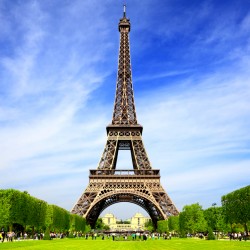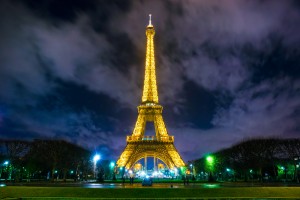When to go to the Eiffel Tower

The Eiffel Tower sees almost 7 million visitors per year, making France’s symbol in the world as well as the most visited monument that you have to pay for in the entire world. Even with the long lines and crowds you have to endure to get to the top, most will tell you that it is an absolute must-do in your lifetime.
The Eiffel Tower, along with its home city Paris, are atop many of bucket lists for travelers in Europe and abroad. It is such an iconic tourist attraction and European landmark. Gazing on it from afar, standing at the base viewing the height, or climbing to the top to witness the expansive view, visitors are often left speechless.
When to go to the Eiffel Tower based on weather
Paris has four seasons throughout the year. Both the summer and winter months have increasingly seen extreme temperatures. Recent summers have risen to occasional 90 degree F days often mixed with heavy air pollution, makes visiting this time of the year seem almost unbearable. The winter months are quite the opposite with extremely low temperatures in the 30’s. If you find yourself at the Eiffel Tower during these two seasons either make sure you bring plenty of water to stay hydrated in the heat or bundle up with lots of layers and jackets during the cold months.
With summer and winter’s temperatures, it makes spring and fall the best time to go based on weather conditions. April through June you will see little rainfall and very mild weather that will make waiting in line for possibly hours much more bearable. The fall months of September through the beginning of November are much of the same as spring; very mild where the air is cleaner and more suitable for enduring large crowds and long lines.
The best time to go to the Eiffel Tower based on crowds
Because most people are aware of the weather conditions and base their trips usually completely around the seasons means that spring and fall tend to be very busy times of the year. Although temperatures can rise in the summer months of July and August, the Eiffel Tower continues to see some of the largest crowds. Expect to wait more than two hours before entering the tower.
This means that the winter sees the least crowds by far. Expect to be waiting up to 30 minutes but usually no less than that in the months of November and December. Although cold, many people still visit the Eiffel Tower in the winter right around Christmas time. If you plan to visit then, be prepared to wait anywhere from one to two hours before entering the tower.
When to go to the Eiffel Tower based on time of day
From mid-June to early September the Eiffel Tower operates 9 am to midnight every single day. The rest of the year the hours are 9:30 a.m. to 11 p.m. besides extended hours until midnight during spring holidays such as Easter weekend.
Although the Eiffel Tower is beautiful at any given time of the day whether rain or shine, most people find that the best time to go is nighttime after the sun has set and the skies have fallen dark. Once you arrive at the top, you will quickly understand why Paris is known as the “City of Lights”. After you have come down and out of the Eiffel Tower at night, stand outside and gaze upon one of their magnificent light shows that occur every single hour staring at 8 p.m. The entire tower sparkles for a total of five minutes and ends at 1 a.m.
Although visiting at night will be nothing short of magical, during the day can be just as great. When it’s light out you are able to see the magnificent structure in a way that isn’t possible at night. There are also several street performers who entertain the crowds during the daytime.
To get a more detailed outline of the peak months to visit the Eiffel Tower, head to: http://toureiffel.fr/images/PDF/prvisions%20daffluence%202015_eng.pdf

